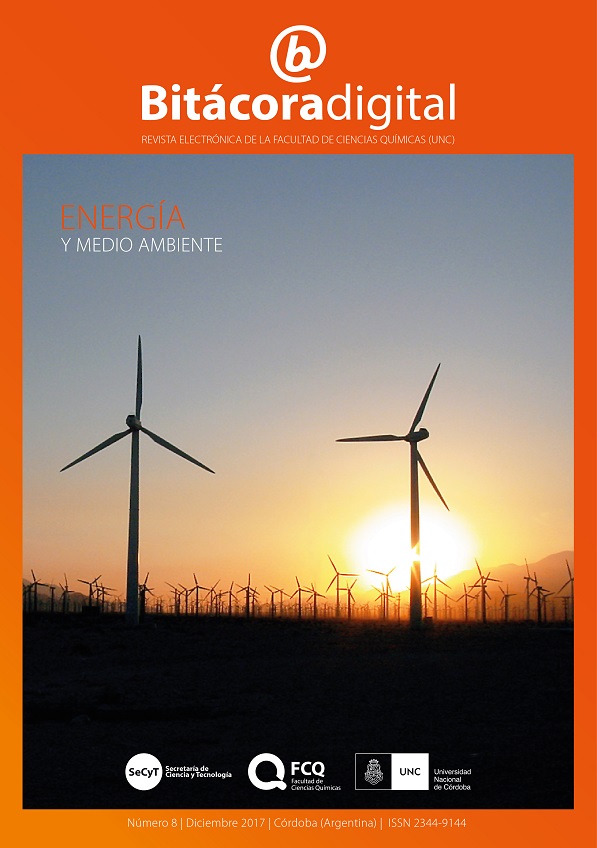Síntesis y caracterización de nanomateriales basados en cobalto: Potenciales aplicaciones en conversión de energía
Abstract
El objetivo de este trabajo fue sintetizar la perovskita SrCoO3-d (0<d<0,5) con tamaño nanométrico, a fin de retener la fase metaestable cúbica a temperatura ambiente, un buen candidato para cátodo en SOFCs. Para ello, se utilizó el método de autocombustión, a partir de nitratos precursores (Sr(NO3)2 y Co(NO3)2·6H2O), utilizando tres combustibles diferentes (glicina, urea y ácido cítrico con etilenglicol) en distintas relaciones combustible/acomplejante. Tratamientos térmicos posteriores son esenciales para una buena cristalización del producto final. El tamaño de cristalita calculado usando la ecuación de Debye-Scherrer está en el intervalo de 50-60 nm. El análisis termogravimétrico mostró la presencia de SrCoO3-? (fase romboédrica). Una banda ancha a ~580 cm-1 en el espectro infrarrojo, pudo atribuirse a la señal característica de perovskitas debida al estiramiento asimétrico Co-O de los octaedros CoO6.
Sin embargo, los patrones de difracción de rayos X de polvos mostraron la formación de la fase Sr6Co5O15 y pequeñas cantidades de SrCO3 y Co3O4 como fases secundarias, también corroborado por FT-IR. De estas observaciones se concluye que la perovskita romboédrica SrCoO3-? es, de hecho, una mezcla de Co3O4 con Sr6Co5O15.
Aunque la fase cúbica, tecnológicamente interesante, no pudo retenerse a temperatura ambiente, la estabilización de la fase Sr6Co5O15 conduce a nuevos desafíos: sintetizar este material en la nanoescala, con un alto grado de pureza y evaluar sus propiedades como dispositivo termoeléctrico para conversión de energía.
The objective of this work was to synthesize the SrCoO3-d perovskite with nanometric size, in order to retain the metastable cubic phase at room temperature, a good candidate for cathode in SOFCs. For this, the self-combustion method was used, starting from nitrate precursors, and using three different fuels (glycine, urea and citric acid with ethylene glycol) in different fuel / complexing ratios. Subsequent thermal treatments are essential for a good crystallization of the final product. The crystallite size calculated using the Debye-Scherrer equation is in the range of 50-60 nm. Thermogravimetric analysis showed the presence of SrCoO3-? (rhombohedral phase) and a wide band at ~580 cm-1 in the infrared spectrum, could be attributed to the characteristic signal of perovskites due to the Co-O asymmetric stretching of the CoO6 octahedra.
However, the X-ray diffraction powder patterns showed Sr6Co5O15 phase and small amounts of SrCO3 and Co3O4 as secondary phases, also corroborated by FT-IR. From these observations we conclude that the rhombohedral perovskite SrCoO3-? is, in fact, a mixture of Co3O4 with Sr6Co5O15.
Although the technically interesting cubic phase could not be retained at room temperature, the stabilization of the Sr6Co5O15 phase leads to new challenges: to synthesize this material at the nanoscale with a high degree of purity and to evaluate its properties as a thermoelectric device for energy conversion.
Downloads
Published
Issue
Section
License
Licencia Creative Commons BY NC
Usted es libre de:
- Compartir — copiar y redistribuir el material en cualquier medio o formato
- Adaptar — remezclar, transformar y construir a partir del material
- La licenciante no puede revocar estas libertades en tanto usted siga los términos de la licencia
Bajo los siguientes términos:
-
Atribución — Usted debe dar crédito de manera adecuada, brindar un enlace a la licencia, e indicar si se han realizado cambios. Puede hacerlo en cualquier forma razonable, pero no de forma tal que sugiera que usted o su uso tienen el apoyo de la licenciante.
-
NoComercial — Usted no puede hacer uso del material con propósitos comerciales.

